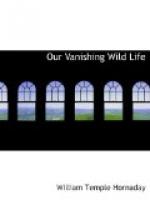Both those things were done,—almost as soon as said! Mr. Carlos Avery, the Executive Agent of the Board of Game and Fish Commissioners of Minnesota is entitled to great credit for the action of his state, and we have to thank Mr. Gifford Pinchot and President Roosevelt for the executive action that represented the first half of the effort.
The new Superior Preserve is valuable as a game and forest reserve, and nothing else. It is a wilderness of small lakes, marshes, creeks, hummocks of land, scrubby timber, and practically nothing of commercial value. But the wilderness contains many moose, and zoologically, it is for all practical purposes a moose preserve.
In it, in 1908 Mr. Avery saw fifty-one moose in three days, Mr. Fullerton saw 183 in nine days, and Mr. Fullerton estimated the total number of moose in Minnesota as a whole at 10,000 head.
In area it contains 1,420,000 acres, and the creation of this great preserve was accomplished on April 13, 1909.
THE WICHITA NATIONAL GAME PRESERVE.—In the Wichita Mountains, of southwestern Oklahoma, there is a National game preserve containing 57,120 acres. On this preserve is a fenced bison range and a herd of thirty-nine American bison which owe their existence to the initiative of the New York Zoological Society. On March 25, 1905, the Society proposed to the National Government the founding of a range and herd, on a basis that was entirely new. To the Society it seemed desirable that for the encouragement of Congress in the preservation of species that are threatened with extermination, the scientific corporations of America, and private individuals also, should do something more than to offer advice and exhortations to the government.
Accordingly, the Zoological Society offered to present to the Government, delivered on the ground in Oklahoma, a herd of fifteen pure-blood bison as the nucleus of a new national herd, provided Congress would furnish a satisfactory fenced range, and maintain the herd. The offer was at once accepted by Hon. James Wilson, Secretary of Agriculture, and the Society was invited to propose a site for a range. The Society sent a representative to the Wichita National Forest Reserve, who recommended a range, and made a report upon it, which the Society adopted.
By act of Congress the range was at once established and fenced. Its area is twelve square miles (9,760 acres). In October, 1908, the Zoological Society took from its herd in the Zoological Park nine female and six male bison, and delivered them at the bison range. There were many predictions that all those bison would die of Texas fever within one year; but the parties most interested persisted in trying conclusions with the famous tick of Texas.
Mr. Frank Rush was appointed Warden of the new National Bison Range, and his management has been so successful that only two of the bison died of the fever, the disease has been stamped out, and the herd now contains thirty-nine head. Within five years it should reach the one-hundred mark. Elk, deer and antelope have been placed in the range, and all save the antelope are doing well. The Wichita Bison Range is an unqualified success.




